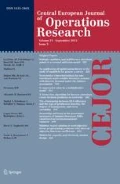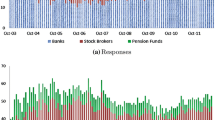Abstract
Professional forecasters in foreign exchange markets are not able to beat naive forecasts. In order to find reasons for this phenomenon we compare the empirical forecasts of experts with the experimentally generated forecasts of novices for the EUR/USD exchange rate in three different forecast horizons. Although the subjects are only provided with the realizations of the exchange rate and are not supported by any statistical procedures they outperform experts in accuracy. Professionals consistently expect a reversal of forgoing exchange rate changes whereas novices extrapolate trends. The judgemental forecasts appear to be unbiased and professionals appear to be biased. We demonstrate that professionals are influenced by the fundamental value—an irrelevant anchor in speculative exchange markets. The poor performance of the experts is not a common failure of human decision-making in market environments but caused by misleading information.
Similar content being viewed by others
References
G.W. Beng and W.K. Siong (1993) Exchange Rate Expectations and Risk Premium in the Singapore/US Dollar Exchange Rate: Evidence from Survey Data. Applied Financial Economics 3, 365–373.
L.D. Brown (1993) Earning Forecast Research: Its Implications for Capital Markets Research. International Journal of Forecasting 9, 295–320.
S. Cavaglia, W.F.C. Verschoor and C.C.P. Wolff (1994) On the Biasedness of Forward Foreign Exchange Rates: Irrationality or Risk Premia? Journal of Business, 321–343.
S. Cavaglia, W.F.C. Verschoor and C.C.P. Wolff (1993) Further Evidence on Exchange Rate Expectations. Journal of International Money and Finance 12, 78–98.
P. Chang and C.L. Osler (1999) Methodical Madness: Technical Analysis and the Irrationality of Exchange-Rate Forecasts. Economic Journal 109, 636–661.
Y. Cheung and M. Chinn (192001) Currency Traders and Exchange Rate Dynamics: A Survey of the US Market. Journal of International Money and Fianance 20, 439–471.
Y. Cheung, M. Chinn and I.W. Marsh (2000) How Do UK-Based Foreign Exchange Dealers Think Their Market Operates?. International Journal of Finance and Economics 9, 289–306.
Y. Cheung and C.Y. Wong (2000) A Survey of Market Practitioners' Views on Exchange Rate Dynamics. Journal of International Economics 51, 401–419.
M. Chinn and J.A. Frankel (2002) Survey Data on Exchange Rate Expectations: More Currencies, More Horizons, More Tests. In: D. Dickinson and W. Allen (eds.) Monetary Policy, Capital Flows and Financial Market Developments in the Era of Financial Globalization: Essays in Honour of Max Frey, London, pp. 145–167.
C.F. Camerer and E.J. Johnson (1991) The process-performance paradox in expert judgment: How can experts know so much and predict so badly? In: K.A. Ericsson and J. Smith (eds.) Toward a general theory of expertise: Prospects and limits, New York: Cambridge Press, pp. 195–217.
D.M. Cutler, J.M. Poterba and L.H. Summers (1990) Speculative Dynamics and the Role of Feedback Traders. American Economic Review, Papers & Proceedings 80, 63–68.
W.P. De Bondt (1993) Betting on Trends: Intuitive Forecasts of Financial Risk and Return. International Journal of Forecasting 9, 355–371.
F.X. Diebold and J.A. Lopez (1996) Forecast Evaluation and Combination. In: G. S. Maddala and C. R. Rao (eds.) Handbook of Statistcis, Vol. 14, Amsterdam, pp. 241–268.
F.X. Diebold and R.S. Mariano (1995) Comparing Predictive Accuracy. Journal of Business & Economic Statistics 13, 253–263.
S.D. Dutt and D. Ghosh (1997) Are Experts' Expectations Rational? A Multicurrency Analysis. Applied Economics 29, 803–812.
G.P. Dwyer, A.W. Williams, R.C. Battalio and T.I. Mason (1993) Tests of Rational Expectations in a Stark Setting. Economic Journal 103, 586–601.
European Central Bank (2002) ECB Monthly Bulletin January 2002, Frankfurt a.M.
M. Friedman (1953) The Case for Flexible Exchange Rates. In M. Friedman (ed.) Essays in Possitive Economics, Chicago, pp. 157–203.
T. Gehrig and L. Menkhoff (2004) Extended Evidence on the Use of Technical Analysis in Foreign Exchange. International Journal of Finance and Economics, forthcoming.
L.P. Hansen and R.J. Hodrick (1980) Forward Exchange Rates as Optimal Predictors of Future Spot Exchange Rates: An Econometric Analysis. Journal of Political Economy 88, 829–853.
J.T. Harvey (1999) The Nature of Expectations in the Foreign Exchange Market: A Test of Competing Theories. Journal of Post Keynesian Economics 21, 181–200.
D. Kahneman, P. Slovic and A. Tverky (1999) Judgement Under Uncertainty: Heuristics and Biases, Cambridge.
B. LeBaron (1999) Technical Trading Rule Profitability and Foreign Exchange Intervention. Journal of International Economics 49, 125–143.
R.A. Meese and K. Rogoff (1983) Empirical Exchange Rate Models of the 1970s: Do They Fit Out of Sample?. Journal of International Economics 14, 3–24.
R.A. Meese and K. Rogoff (1983) The Out-of-Sample Failure of Empirical Exchange Rate Models: Sampling Error or Misspecification?. In J.A. Frenkel (ed.) Exchange Rates and International Macroeconomics, Chicago, pp. 67–105.
L. Menkhoff (1998) The Noise Trading Approach—Questionnaire Evidence from Foreign Exchange. Journal of International Money and Finance 17, 547–564.
I.A. Moosa (2000) Exchange Rate Forecasting: Techniques and Applications, Basingstoke.
C.J. Neely (1997) Technical Analysis in the Foreign Exchange Market: A Layman's Guide. In: Review—Federal Reserve Bank of St. Louis, 79, pp. 23–38.
C.J. Neely (2002) The Temporal Pattern of Trading Rule Returns and Exchange Rate Intervention: Intervention Does Not Generate Technical Profits. Journal of International Economics 58, 211–232.
W.K. Newey and K.D. West (1987) A Simple Positive Semi-Definite Heteroskedasticity and Autocorrelation Consistent Covariance Matrix. Econometrica 55, 703–708.
J. Okunev and D. White (2003) Do Momentum-Based Strategies Still Work in Foreign Currency Markets?. Journal of Financial and Quantitative Analysis 38, 425–447.
K. Rogoff (2001) The Failure of Empirical Exchange Rate Models: No Longer New but Still True. Economic Policy Web Essay 1.
L. Sarno and M.P. Taylor (2002) The Economics of Exchange Rates, Cambridge.
S. Schneider (2003) The Euro—What Went Down Must Go Up?. Deutsche Bank AG.
J. Shanteau (1992) Competence in experts: The role of task characteristics. Organizational Behavior and Human Decision Processes 53, 252–266.
D. Sobiechowski (1996) Rational Expectations in the Foreign Exchange Market? Some Survey Evidence. Applied Economics 28, 1601–1611.
M.P. Taylor and H. Allen (1992) The Use of Technical Analysis in the Foreign Exchange Market. Journal of International Money and Finance 11, 304–314.
M.E. Thomson, D. Önkal-Atay, A.C. Pollock and A. Macaulay (2003) The Influence of Trend Strength on Directional Probabilistic Currency Predictions. International Journal of Forecasting 19, 241–256.
T.H. Van Hoek (1992) Explaining Mark/Dollar and Yen/Dollar Exchange Rates in the 1980s. Economic Letters 38, 467–472.
Zentrum für Europäische Wirtschaftsforschung (ZEW) (2004) ZEW Finanzmarktreport, February 2004.
Author information
Authors and Affiliations
Rights and permissions
About this article
Cite this article
Leitner, J., Schmidt, R. A systematic comparison of professional exchange rate forecasts with the judgemental forecasts of novices. cent.eur.j.oper.res. 14, 87–102 (2006). https://doi.org/10.1007/s10100-006-0161-x
Issue Date:
DOI: https://doi.org/10.1007/s10100-006-0161-x



